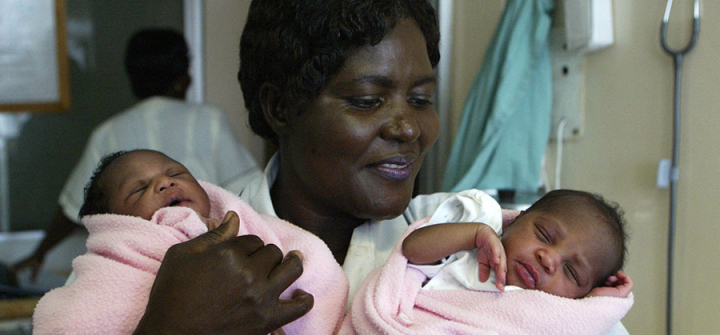Infertility as a Neglected Disease
"Infertility in low-income countries is a neglected reproductive health issue, despite its staggering impact," wrote Marie Thoma, PhD, MHS, nominating it for Global Health NOW's annual Untold Stories of Global Health Contest in 2019. "It is also under-measured, especially in low-income settings—but a new approach to measuring the extent of the problem could be a catalyst for change." Thoma, an assistant professor at the University of Maryland who studies the epidemiology of infertility, won an honorable mention for her submission, leading to this report.
Agatha* lives in Ghana and has not been able to have a child, despite years of visits to pastors, traditional healers, and eventually, medical doctors. “You always feel like you’re not complete,” she said by phone. Her husband now spends most of his time with the wife he took after Agatha failed to become pregnant, with whom he’s had several children. Agatha won’t tell me her age, but she will tell me about how it feels not to have a child. “I cannot explain the emptiness. I don’t wish even an enemy to experience what I have gone through.”
Thema* also spent years trying to conceive with her husband. “When you get married and don’t get pregnant, people talk,” she says. She knew people in her village were gossiping about her, and saying she must be a bad person. Between the gossip and her own deep sorrow about not being able to conceive, she says the mental anguish was nearly unbearable.
When the world is more threatened by overpopulation than underpopulation, should the sorrow of these women be a public health concern?
It's an especially fraught question now at the height of the coronavirus pandemic—infertility treatment involves health personnel and supplies that may be needed elsewhere, exposure to others, and for villagers living far from cities, often requires extensive travel. But infertility in LMICs has been a matter of global indifference since long before the birth of the first test tube baby in 1978.
A commission supported by The Lancet and the Guttmacher Institute estimates that between 49 million and 180 million couples worldwide are affected by infertility; the prevalence has not decreased in 20 years. It affects up to 15% of reproductive-aged couples worldwide, according to a 2010 WHO estimate. And it’s more common in poor countries because of a higher prevalence of untreated STDs and pregnancy-related infections.
In 2013, Canadian ethicist Marie-Eve Lemoine and colleagues made the case for fertility as a human right in a paper in the journal Public Health Ethics. Infertility is often blamed on the woman even when it may be the man who is at fault. Lemoine and her colleagues note that in developing countries, women who don’t have children are subject to ostracism and isolation, and suffer economically when their partners leave them.
The researchers concluded that accepting infertility in the context of overall population growth is unethical. “Ignoring the needs of the infertile minority,” they write, “is not the appropriate way to control population growth in overpopulated countries.”
Many of the advocates for more attention to infertility say making medical care available should be part of family planning programs. Mahmoud Fathalla, the former director of HRP (Human Reproduction Programme) a joint reproductive health program of the WHO, World Bank and other institutions, writes, “If couples are urged to postpone or widely space pregnancies, it is imperative that they should be helped to achieve pregnancy when they so decide, in the more limited time they will have available.” Otherwise they may not be so willing to use contraception in their younger years.
Financial support for infertility treatment in LMICs has been almost non-existent. HRP lists only 3 small NGOs on its website. Ask Marie Thoma, an assistant professor at the University of Maryland who studies the epidemiology of infertility, about funding for research and she laughs. The first paper she co-authored was unfunded. The Guttmacher Institute has offered some support, and Thoma says several US government agencies have recently shown some interest.
The Merck Foundation is one of the few NGOs dedicated to infertility, with a program called “More than A Mother” in sub-Saharan Africa. The Foundation has several goals: to reduce stigma by educating the public through singing and dancing, training health care providers, and pushing governments to offer access to infertility care.
Rudolph Kantum Adageba, a Ghanaian OB/GYN, runs the clinic where Agatha and Thema sought care. He trained in Russia, India, and the US, then returned to his native Ghana to help women there. Adageba’s clinic in Kumasi is one of several in Ghana. None are supported by the country’s public health sector.
Adageba says there should be more government support. “Lack of fertility care is unfair and discriminatory because infertility is a disease,” he says. “It is a huge problem in Ghana not to have children, especially for the women.” Agaba and Thema’s stories are not unusual. “Women are stigmatized, at risk of divorce, at risk of being mocked by other women, and they are not treated with respect,” he says.
But counting cases is difficult. Maria Thoma’s interest in infertility began when she realized how sparse information is on infertility in LMICs. As a side project while writing up a study on of infertility among women in the US, she looked into what was happening in poorer countries. She found only bits of information. “Infertility is hard to measure,” Thoma says. “It’s not getting pregnant after a period of time: It’s a non-event.” So she and her colleagues worked out a theoretical way to estimate infertility in LMICs.
Men present a special problem. Measuring male infertility requires sperm counts, which can be expensive to do and require a certain amount of cooperation by men who might be uncomfortable with the request for a sample. And if they live in a place where infertility is automatically assumed to be the fault of the woman, they may not want to find out.
Adageba, the OB/GYN in Ghana, is trying to garner more interest in infertility. During his residency training, he noticed there was nothing his hospital could offer to women who had problems such as tubal blocking. Today he runs one of several fertility clinics in Ghana. At his hospital in Kumasi, hundreds of women go through a total of about 500 IVF cycles per year, and $4,000 to $5,000 out-of-pocket—far lower than fees in wealthier countries, but a fortune for many Ghanaians. Although Ghana has a good health insurance system, it doesn’t offer any financial support for fertility treatments. Says Adageba, “People save for years. They take out loans, sell personal property.” Both Agatha and Thema took out loans they’re still repaying years later.
Adageba’s patients tend to wait too long to seek care. “People go for prayers, herbalists, pastors,” he says. “They go to places where the problem cannot be solved, and they waste time and money. Age has caught up with the women.” The current coronavirus pandemic, meanwhile, has curtailed IVF treatments at Adageba’s clinic and at clinics around the world until COVID-19 is no longer a threat.
Adageba’s patient Thema eventually did get pregnant, and at the age of 43 is a very proud mother. “I was lucky,” she says. “The baby is almost 3 years old.” She’s nearly forgotten the 8-hour long bus trips she took several times to reach the clinic, and the loans her husband took.
As of several months ago, Agatha had not gotten pregnant. She had vowed through tears never to give up. But she no longer responds to phone messages, and has not been seen at her treatment center for months.
*Not her real name
For the latest, most reliable COVID-19 insights from some of the world’s most respected global health experts, see Global Health NOW’s COVID-19 Expert Reality Check.
Join the tens of thousands of subscribers who rely on Global Health NOW summaries and exclusive articles for the latest public health news. Sign up for our free weekday newsletter, and please share the link with friends and colleagues: https://www.globalhealthnow.org/subscribe
A maternity matron holds 2 baby girls, the first children conceived through IVF in Kenya, May 2006. Image: Simon Maina/AFP/Getty




